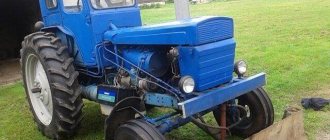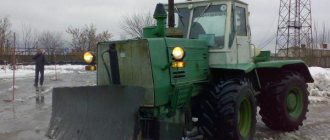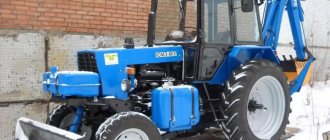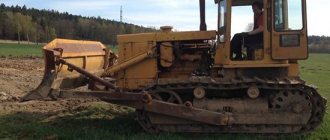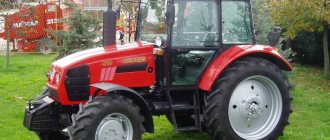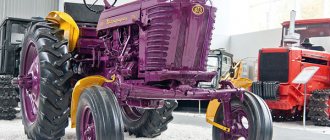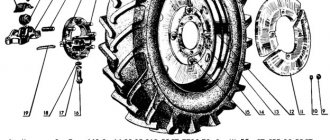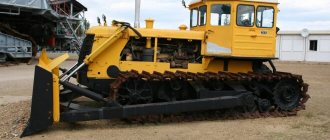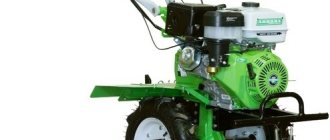The T-30 tractor appeared in the production program of the Vladimir Tractor Plant in the mid-70s. last century. According to its characteristics, the machine was an improved version of the T-25 tractor, equipped with an improved engine, hydraulic steering and a cabin with a heating system.
Technical characteristics of the T-30 tractor
The Vladimirets T-30 tractor belongs to the category of universal wheeled vehicles with a traction class of 0.6 tons.
The machine is designed to perform work in the following categories:
- inter-row processing;
- soil preparation during the sowing campaign;
- cargo transportation;
- maintenance of livestock farms;
- communal sphere.
The dimensions of the mini tractor model T-30 are suitable for working in cramped conditions:
- length - 3180-3320 mm;
- width - 1560-1665 mm;
- height (with metal cabin) - 2605 mm;
- ground clearance (all-wheel drive version) - 345 mm.
The weight of a tractor filled and loaded with ballast ranges from 2022 (model 30-69) to 2500 kg (version 30A-80).
Modern tanks
After the war, light, medium and heavy tanks continued to be produced, but by the end of the 50s, all major tank manufacturers concentrated on the production of the main tank. Thanks to new technologies in the production of armor, more powerful engines and weapons, the need to divide tanks into types disappeared by itself. The niche of light tanks was occupied by armored personnel carriers and infantry fighting vehicles, so the PT-76 eventually became an armored personnel carrier.
The first post-war mass-produced tank of the new type was the T-54, armed with a 100-mm gun, and its modification for use in radioactive zones, the T-55. This model became the most popular among modern tanks; more than 30,000 of these vehicles were in service in over 30 countries.
After tanks with a 105 mm gun appeared among potential enemies, it was decided to upgrade the T-55 to a 115 mm gun. The world's first tank with a 155mm smoothbore gun was named T-62.
The ancestor of the classic main tanks was the T-64. It fully combined the capabilities of heavy (125mm gun) and medium tanks (high mobility).
The following production models T-72, T-80, T-84, T-90, T-95 became the embodiment of human genius, without changing in the classical sense, but changes in the “filling” made them completely different, and at the same time similar.
More material on the topic
- M4 Sherman
- War Thunder on the Japanese in realistic battles. Cutting...
Engine
The T-30 is equipped with a 2-cylinder 4-stroke air-cooled diesel engine D-120. The engine is produced by the Vladimir Tractor Plant. It is possible to use several modifications of the engine, differing in the number of plungers in the fuel pump, the installation of a compressor for the pneumatic system, and the presence of oil drainage from the crankcase for heating the cabin. A design feature of a diesel engine is the placement of the combustion chamber in the piston. This ensures improved mixture formation and complete combustion of fuel.
The engine is equipped with removable cylinders of interchangeable design. The cylinders are cast from cast iron, with cooling fins located on the outer part. The inner surface of the cylinder forms a mirror. If the cylinders are worn or damaged, they cannot be repaired. The cylinder heads are individual, equipped with intake and exhaust valves, a fuel injection nozzle and a decompressor valve.
The camshaft is located in the engine crankcase. The shaft drive is carried out by a block of gears located in the front part. The gears are covered with a cover. The block contains guide bushings through which the pushers pass. As the camshaft rotates, the cams move the pushrods upward. The pushers are connected to rocker arms mounted on the head. The rocker opens the valve by acting on the end of the rod. The closing of the valves and the return of the pushers to the lower position is carried out due to the force of compressed springs installed in the valve mechanism.
Cooling is carried out by air flow generated by an axial fan. Belt drive from a pulley on the engine crankshaft. Air is supplied to the cavity of the casing mounted on the side of the cylinders. The air flow is directed by deflectors and flows around the fins. Under the casing there is a radiator for the engine lubrication system. The intensity of the air flow is adjusted by turning the disc valve located at the air intake inlet.
Cabin and controls
The driver's cabin of the T-30 tractor has a frame type construction. It has built-in equipment such as air conditioning and a fan. Thanks to this device, a high level of comfort is ensured in the cabin, regardless of the temperature conditions established outside and outside the cabin. The figure below shows the layout and functions of the devices of this vehicle.
To improve the cabin and viewing angle, it can be glazed on all sides. Such improvements will lead to better tractor control and more functional operation.
The control panel and steering wheel have a standard layout for tractors of this model.
Attachments
- snow removal/utility blade;
- utility brush (suitable for models T30, T25, T45);
- double/four-furrow plow;
- potato digger of screening type;
- universal single-row/double-row potato planter;
- cutter-cultivator (2.1 m);
- shovel;
- hydraulic rakes;
- fertilizer diffuser;
- three-row cultivator-hiller;
- rakes;
- rotary rakes;
- rotary mower type Zarya;
- disc harrow.
Fertilizer spreader
Brush
Disc harrow
Rotary mower
Four-furrow mounted plow PLN 4-35
Potato digger DTZ-2T
Continuous tillage cultivator KSO-2.1
Mounted tiller
All attachments from Belarus tractors and mini tractors are successfully suitable for T-30 devices and modifications.
Transmission
The transmission includes a clutch mechanism and a gearbox. The machines use a clutch with a dry operating principle. The clutch is equipped with 1 disc and is in a permanently closed state. When installing an additional shaft on the tractor to drive implements (PTO), a separate disk is added to the coupling to transmit torque to the shaft.
The manual gearbox and doubler in the rear axle reducer provide 6 normal forward speeds. The reversible gearbox allows you to use these gears for moving backwards. When working in off-road conditions, 2 additional gears are used, allowing you to move in slow motion. Slow speeds only apply to forward movement.
On vehicles of the T-30 family, 2 types of PTO are used - dependent and independent. Both options provide 1 operating speed - 540 rpm. Drive shafts differ in diameter and number of splines; there are 2 configuration options.
Gear box
The T-30 Vladimirets tractor has an eight-speed gearbox for moving forward and a four-speed gearbox for moving backward. Thanks to such a large gear shift range, the tractor can operate at speeds from 1.5 to 23.9 kilometers per hour. The arrangement of control parts in the T-30 tractor is presented below.
Device
“Vladimirovets” T-30 is described as a device equipped with a strong body (frame), ensuring safety during work. This machine has swivel front wheels, which gives excellent maneuverability. The rear wheels are driven and larger, providing excellent maneuverability. The cabin has a heating and cooling device. The model is equipped with two handles and foot pedals for control. The device is manufactured in Vladimir. All structures and parts have high strength and fastening, ensuring safety and greater power. Based on their impeccable quality, the “brainchildren” of this plant produced a boom and became in great demand. That is why the range of Vladimirets tractors includes machines that perform work not only in the agricultural spectrum, but in household and personal use. At the moment, the model is not in production, but thanks to the long period of use, if you purchase a used device, it will serve you for many more years without any problems.
Front and rear axle
The front axle is a beam mounted on a balancer. The T-30A-80 modification is equipped with a front drive axle with an automatic connection system when the wheels on the rear axle slip. The drive is carried out by a cardan shaft from a gearbox located on the gearbox.
The rear axle gearbox is equipped with a differential with the possibility of mechanical locking by a pedal. The axle shafts are located in the side sleeves, on which the final drive reduction gearboxes are mounted. Rear axle gearboxes allow you to change the vehicle's ground clearance.
Chassis system
Tractors use wheels with different diameters on the front and rear axles. The machines are equipped with a track adjustment system on the front and rear axles. The front axle has 3 stages of adjustment every 100 mm. The track of the bridge equipped with a drive is 100 mm larger than the track of the standard unit.
The rear wheels allow you to adjust the track in 4 steps.
Disc-type brakes are installed on the rear axle. Separate control is carried out by 2 pedals from the operator's cabin. The parking brake uses operating mechanisms. Model 30-69 vehicles use a mechanical steering gear. Versions 30-70 and 30A-80 received hydrostatic control with a power cylinder mounted on the front axle.
Tractor structural elements
Engine
The T-25 tractor was equipped with a two-stroke diesel engine with a D-21 air cooling system.
It was an in-line two-cylinder version of a reliable engine, which had four and six-cylinder versions with larger sizes for other types of tractors.
This made it possible to achieve unification and ensure maintainability and light weight of the D-21. On the T-25, due to the use of equipment in the fuel circuit, low-quality fuel was used.
Previously, this property was provided by the fuel pump and fuel filter. An appropriate adjustment of the fuel injection pump on the T-25 was required.
Long-term operation of the engine on low-quality fuel led to increased consumption or breakdown of the injection pump with subsequent repairs.
The economical operation of the power unit was achieved by correct installation and adjustment of the ignition in the fuel supply system. Therefore, every machine operator knew how to correctly set the ignition on the T-25.
Cabin
The tractor was equipped with a single-seat cabin, the feature of which was glazing, which made it possible to carry out agricultural operations.
The power supply of Vladimirets was achieved with an oversized T-25 generator; the control system used electrical equipment, an electric starter (instead of a gasoline starter), front and rear lights, and indicator lamps for the functioning of individual units.
An adjustable steering column improved the operator's working conditions. Among the shortcomings in the design of the cabin were low noise insulation and insufficient heating for work in winter conditions.
The alternator belt could not withstand intense loads and required replacement. The machine operator could install the new belt himself, and to improve heating, additional homemade heaters with a large weight were used.
Chassis and transmission
The T 25 has a classic tractor chassis with a driven rear axle and a front axle with reduced wheels.
The T-25 with a front drive axle was produced in small batches for individual orders. The T 25 tractor uses a mechanical transmission option, which includes the following units:
- manual gearbox;
- clutch;
- rear power take-off shaft for linkage.
T-25 is a universal tractor for agricultural operations. When performing, for a high-quality result, maintain the speed of movement.
The T-25 speed provides a clutch that requires periodic adjustment. The clutch design is highly reliable, but the operator must know the description and procedure for how to adjust and configure the clutch. Frequent features of mechanism breakdowns include:
- basket defects;
- breakage of legs and springs;
- clutch disc wear.
The chassis on the T-25 tractor consists of:
- front and driving rear axles;
- semi-frame frame;
- steering device;
- wheels
Important elements of the chassis are the rear wheels installed on the T-25. They provide cross-country ability and traction parameters of the tractor.
Wheels with tires or rubber of the following size are installed on the rear axle: 9-32 and operating pressure from 0.80 to 1.10 kg/cm2.
Hydraulic system
The device and parameters made it possible to combine the tractor with a large number of agricultural implements:
- pump NSh 10 or NSh 16;
- mechanical drive of the oil pump;
- oil filter;
- oil temperature sensor (indicator).
The hydraulic system tank holds 7.50 liters of oil. The reasons that most often served as the basis for breakdowns were low-quality oil poured into the hydraulics and a break in the NSh 10 pump drive.
Important Do-it-yourself manufacturing and adjustment of a plow on the MTZ-82
Main modifications
All models based on the T-30 are equipped with the same power plant and gearbox. Some components and assemblies were subject to changes.
The VTZ plant produced several versions of the machine:
- The T-30-69 tractor, which is distinguished by the installation of a dependent PTO and an additional drive disk in the clutch. The machine was positioned as an agricultural one, for performing auxiliary work.
- The T-30-70 model is equipped with a reinforced clutch with 2 discs and an additional clutch for driving an independent PTO. The vehicle was created to work on vineyards and transport goods.
- A variant of the T-30A-80 tractor, which is equipped with a transfer gearbox and a driving front axle. Hydraulics with increased performance.
- Model T-45 with a 3-cylinder diesel engine D-130 with a power of 45 hp. It was not produced for long, but thanks to its powerful engine it had improved performance characteristics.
- The utility version of the T-30KO was equipped from the factory with equipment for street cleaning. The modifications listed above served as the basis.
Tanks of the Second World War
Participation in the Spanish Civil War and in the battles at Khalkhin Gol showed how high the explosion hazard of a gasoline engine is and the inadequacy of bulletproof armor against the then nascent anti-tank artillery. The implementation of solutions to these problems allowed our designers, who had suffered from the disease of imitation, to create truly good T-34 and KV tanks on the eve of the Second World War.
In the first days of the war, a catastrophically large number of tanks were lost; it took time to establish production of the uncompetitive T-34 and KV at the only evacuated factories, and the front desperately needed tanks. The government decided to fill this niche with cheap and quick-to-produce light tanks T-60 and T-70. Naturally, the vulnerability of such tanks is very high, but they gave time to expand the production of Victory tanks. The Germans called them “indestructible locusts.”
In battle under the railway. Art. Prokhorovka was the first time that tanks acted as “cementers” of the defense; before that they were used exclusively as attack weapons. In principle, until today, there have been no more new ideas for the use of tanks.
Speaking about WWII tanks, it is impossible not to mention tank destroyers (SU-76, SU-122, etc.) or “self-propelled guns” as they were called in the troops. The relatively small rotating turret did not allow the use of some powerful guns and, most importantly, howitzers on tanks; for this purpose, they were installed on the bases of existing tanks without the use of turrets. In fact, Soviet tank destroyers during the war, except for weapons, were no different from their prototypes, unlike the same German ones.
Advantages and disadvantages
The characteristics of the T-30 tractor provide a number of advantages:
- ground clearance allowing for work in the field;
- closed cabin with large glass area;
- adjustment of track and ground clearance;
- low fuel consumption;
- ease of repair and maintenance;
- ability to work with various attachments.
Reviews of equipment allow us to highlight a number of disadvantages of the machine:
- low location of the front axle drive shaft;
- the need to adjust the clearance in the clutch;
- low comfort of the operator's cabin.
Purpose of the machine
Like its predecessor with a 25-horsepower engine, the T-30 tractor (“Vladimirovets”) was initially aimed at the rural sector. This is a universal all-terrain wheeled row-crop machine, optimized for plowing on light soils and other pre-sowing agricultural work. The equipment is also used in gardens, farms, vineyards, for maintaining rows and in transport work - where great power and solid traction force are not required, but efficiency and endurance are more valued.
The tractor turned out to be so successful that modifications soon appeared, adapted for urban conditions - for work in public utilities.
Using the T-30 tractor
The machine can operate with various coupling equipment weighing up to 600 kg. Although, on the same base, a version with an improved hydraulic system was produced, the towing devices of which could already withstand 1000 kg.
The tractor was produced unchanged until 2008. Although modern models, in fact, are still the same T-30, albeit subjected to deep modernization. Such equipment is in greatest demand in small farms with a cultivated area of 3-4 hectares.
User manual
The basic rules and recommendations for repairing and running in the T-30 tractor are specified in the instructions for its operation, which are attached to the vehicle itself.
Basic faults
When working on the T-30 tractor, the following types of malfunctions and problems most often arise.
The engine gets very hot:
- part of the engine is clogged, it needs to be cleaned;
- the fan protection grid is clogged, you need to wash it;
- The fan belt is not tensioned enough or is broken; the belt needs to be tightened or replaced;
- excess or lack of lubricant, it is necessary to add or remove it;
- Engine load is too high.
Insufficient engine power:
- The fuel system filter is very clogged and needs to be cleaned;
- the vehicle injectors are faulty and need to be adjusted or replaced;
- The fuel pump is broken and needs to be replaced.
If problems arise with the drive front end, you should immediately contact a professional service for repairing special equipment.
Maintenance and repair
In order to extend the life of the T-30 Vladimirets tractor, it is necessary to carry out regular maintenance. After completing daily agricultural work, it is necessary to completely clean the special equipment from accumulated dirt and other elements. This helps slow down the formation of corrosion on metal parts of the vehicle.
The engine oil must be changed regularly every 250 hours of using the tractor. The hydraulic type of oil must be replaced every 500 hours of tractor operation. The transmission oil should only be changed once during service and repairs at the beginning of the season.
Maintenance of the Vladimirets T-30 tractor is best carried out by a professional service center. There you can get guarantees on service life and be sure that all technical work has been carried out in the correct order.
Rules of operation and maintenance
In order for the T-28 to serve for a long time and properly, you must follow the following rules:
- Maintain tire pressure as specified in the owner's manual.
- Carry out maintenance on time, replace oil and air filters.
- Keep the oil level within acceptable limits.
- Use fuel and lubricants of good quality.
- Check the serviceability and reliability of fastenings of attachments.
- Before starting, check the level of diesel fuel in the tank.
Service:
- Before each working season, it is necessary to update fuel and lubricants;
- before preserving the equipment before the winter months, you need to drain the oil and fuel, since it is impossible to leave the tractor with liquids for the winter;
- Regularly inspect and maintain all moving parts; if faults are found, replace them.
Important: TOP 5 electric and 2 gasoline models of Japanese Makita lawn mowers
Some parts were unified and suitable for tractors of subsequent generations. So the tractor plant willingly produced additional spare parts. However, nowadays they are quite difficult to find.
In order for the T-28 tractor to serve for a sufficiently long time, it is necessary to carry out mandatory conservation of the technical equipment for the winter. Clean from dirt, dust, wash, then place in a room without high humidity. The fluids are drained and the wires and spark plugs are disconnected. To prevent corrosion, you can also lubricate the parts.
This model has not been produced for a long time, so there is no need to run it in after the factory.
Possible malfunctions and their elimination
The tractor is highly reliable and, with proper maintenance, rarely breaks down.
The most common malfunctions of the T-28 tractor
| Malfunction | Recommendation |
| Fuel line clogged | Wash and blow out the fuel line, check the filters |
| Fuel pump failure | Remove, adjust or replace the pump |
| Heavy smoke from engine when starting | Warm up the engine by reducing the load |
| Foreign noises during operation | Overhaul the engine and transmission |
| Oil waste | Check the components for leaks and check the condition of the piston rings |
Marina
July 2, 2018
Article rating:
Loading…
Price and owner reviews
The cost of used cars starts from 100 thousand rubles. For this price, tractors are offered with standard equipment without attachments. The remaining life of the machines is small; most require major repairs of the engine and transmission. More recent copies cost from 200 thousand rubles. Additional equipment brings the cost to 400 thousand rubles and above.
The cost of the VTZ-2032 tractor in the version with rear drive wheels is 495 thousand rubles, with all-wheel drive - from 60 thousand rubles.
Special equipment can be purchased from official dealers in new condition or you can find a used version on the secondary market. The T30a tractor is a new modification and its price starts from 600,000 rubles.
If you need a cheaper analogue of agricultural machinery, then it is recommended to consider the T25 tractor. Its price starts from 235 thousand rubles.
Artem, Tver region.
There are 3 vehicles in operation, modification 30A-80, produced in the mid-2000s. and 1 model - late 90s. On late-release tractors, there are problems with the axle gearbox associated with breakage of shafts and gears. After replacement, the parts do not last long. There are no such problems on an early car. The transfer case and driveshaft are installed low, which causes damage to the unit. There is a high probability of impacts on the crankcase when driving in deep ruts. The engine for all-wheel drive has low power, on the other hand, the chassis cannot cope with more power.
Dmitry, Sochi.
The tractor is used for forestry. Equipped with cabin and glass protection. Protective screens for the front axle drive and oil pump are installed from the factory. The kit included a skidding blade on the front linkage and a forestry plow. The blade was used for lifting purposes; the hydraulic power was enough to move large tree trunks. The vehicle's cross-country ability is at the level of GAZ-66 trucks with all-wheel drive. The cooling system is reliable, it is almost impossible to overheat the engine.
History of invention
The primacy of the use of tanks belongs to the British; their use of tanks in the First World War forced military leaders of all countries to reconsider the concept of warfare. The use by the French of their Renault FT17 light tank determined the classic use of tanks for solving tactical problems, and the tank itself became the embodiment of the canons of tank building.
Although the laurels of first use did not go to the Russians, the invention of the tank itself, in its classical sense, belongs to our compatriots. In 1915 V.D. Mendeleev (the son of a famous scientist) sent a project for an armored self-propelled vehicle on two tracks with artillery weapons to the technical department of the Russian Army. But for unknown reasons, things did not go beyond design work.
The idea itself of installing a steam engine on a caterpillar propulsion device was not new; it was first implemented in 1878 by Russian designer Fyodor Blinov. The invention was called: “A car with endless flights for transporting goods.” In this “car”, a track turning device was used for the first time. The invention of a caterpillar propulsion device, by the way, also belongs to the Russian staff captain D. Zagryazhsky. For which a corresponding patent was issued in 1937.
The world's first tracked combat vehicle is also Russian. In May 1915, tests of the armored vehicle D.I. took place near Riga. Porokhovshchikov called “All-terrain vehicle”. It had an armored body, one wide track and a machine gun in a rotating turret. The tests were considered very successful, but due to the approaching Germans, further tests had to be postponed, and after some time they were completely forgotten.
In the same year, 1915, tests were carried out on a machine designed by the head of the experimental laboratory of the military department, Captain Lebedenko. The 40-ton unit was an artillery carriage enlarged to gigantic proportions, driven by two Maybach engines from a downed airship. The front wheels had a diameter of 9 meters. According to the creators, a vehicle of this design should easily overcome ditches and trenches, but during testing it got stuck immediately after it started moving. Where it stood for many years until it was cut up for scrap metal.
